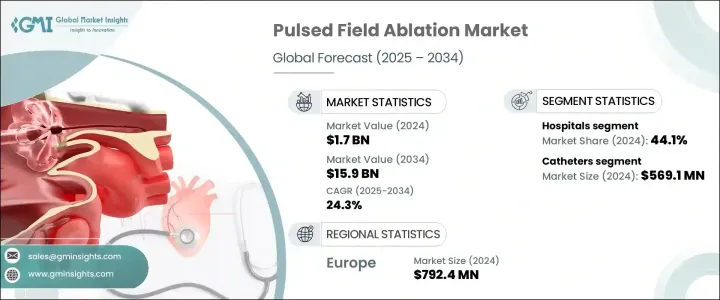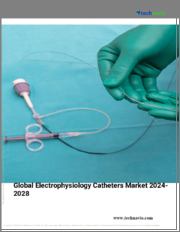
|
시장보고서
상품코드
1766183
펄스 필드 절제 시장 기회, 성장 촉진요인, 산업 동향 분석, 예측(2025-2034년)Pulsed Field Ablation Market Opportunity, Growth Drivers, Industry Trend Analysis, and Forecast 2025 - 2034 |
||||||
세계의 펄스 필드 절제 시장은 2024년에는 17억 달러로 평가되었고, 2034년에는 159억 달러에 이르며 CAGR은 24.3%의 성장이 예상됩니다.
시장의 주요 원동력은 기존의 열 절제법에 비해 회복 시간이 짧고 합병증이 적은 저침습 절차에 대한 수요가 증가함에 따라 심방세동을 중심으로 하는 부정맥의 유병률이 증가하는 것입니다. 전기 천공(IRE)을 일으켜 세포사멸과 조직의 흉터화를 가져옵니다.

로봇 지원에 의한 펄스 필드 절제(PFA) 수술의 통합이 진행되어, 고급 화상 기술의 사용과 함께, 절제 치료의 정밀도와 효율이 대폭 향상하고 있습니다. 또한 심장의 특정 부위를 표적으로 할 수 있습니다. 이 정확도는 전통적인 방법으로 위험이 높거나 성공률이 낮아지는 복잡한 부정맥 환자에게 특히 유익합니다.
| 시장 범위 | |
|---|---|
| 시작 연도 | 2024년 |
| 예측 연도 | 2025-2034년 |
| 시작 금액 | 17억 달러 |
| 예측 금액 | 159억 달러 |
| CAGR | 24.3% |
카테터 부문은 2024년에 5억 6,910만 달러를 창출했고 펄스 필드 절제 시장의 지배적인 선수가 되었습니다. 일회용 소모품인 이러한 카테터는 PFA 산업의 지속적인 기능과 성장에 매우 중요하며, 특히 대량의 전기 생리학 센터와 병원에서는 정기적인 교환과 보충이 확실히 이루어집니다.
2024년 병원 부문의 점유율은 44.1%였습니다. 이런 이점은 고급 수술 인프라와 충분한 훈련을 받은 의료 팀이 있는 병원에서 심장 수술이 높은 빈도로 이루어지고 있는 것이 주된 이유입니다. 최전선에 오랫동안 서 있어 복잡한 수술을 실시해, 수술 후의 케어를 제공할 수 있는 병원은 PFA를 둘러싼 상황에 있어서 중요한 역할을 담당하고 있어, 이 수술의 보급을 확실하게 하고 있습니다.
유럽의 펄스 필드 절제 시장은 2024년 시장 규모가 7억 9,240만 달러였습니다. 기술을 의료 제공자에게 신속하게 전달할 수 있는 합리화된 승인 프로세스 등 강력한 규제 지원으로부터 혜택을 받고 있습니다. 또한, 유럽에서는 저침습의 전기생리학적 기술에 중점을 두고 있기 때문에 특히 부정맥에 대한 침습성이 낮고, 정밀도가 높은 치료를 요구하는 경향이 강해지고 있어 PFA의 채용
세계의 펄스 필드 절제 산업의 주요 기업은 Abbott, Boston Scientific, CARDIOFOCUS, Johnson & Johnson, Medtronic 등입니다. 펄스 필드 절제 시장의 각 회사는 선진적인 PFA 카테터와 발전기의 도입으로 제품 포트폴리오의 충실에 주력하는 한편, 기기의 안전성과 유효성의 전체적인 향상에도 임하고 있습니다. PFA 기술의 장점을 증명하기 위해 임상시험과 연구에 투자하고 있습니다.
목차
제1장 조사 방법과 범위
제2장 주요 요약
제3장 업계 인사이트
- 생태계 분석
- 업계에 미치는 영향요인
- 성장 촉진요인
- 심방세동의 유병률 증가
- 저침습 수술 수요 증가
- PFA 기술의 진보
- 열 절제에 비해 짧은 치료 시간과 적은 합병증
- 업계의 잠재적 위험 및 과제
- 숙련된 전기생리학자의 부족
- 시장 기회
- PFA와 고급 매핑 및 내비게이션 시스템의 통합
- 부정맥 치료의 미충족 요구가 높은 신흥 시장에의 진출
- 성장 촉진요인
- 성장 가능성 분석
- 상환 시나리오
- 규제 상황
- 미국
- 유럽
- 기술과 혁신의 상황
- 현재의 기술 동향
- 신흥기술
- 갭 분석
- Porter's Five Forces 분석
- PESTEL 분석
- 밸류체인 분석
제4장 경쟁 구도
- 서론
- 기업 매트릭스 분석
- 기업의 시장 점유율 분석
- 지역별
- 세계
- 미국
- 유럽
- 지역별
- 주요 시장 기업의 경쟁 분석
- 경쟁 포지셔닝 매트릭스
- 주요 발전
- 합병과 인수
- 파트너십 및 협업
- 신제품 발매
- 확장 계획
제5장 시장 추정·예측 : 제품 유형별(2021-2034년)
- 주요 동향
- 발전기
- 카테터
- 액세서리 장치
제6장 시장 추정·예측 : 최종 용도별(2021-2034년)
- 주요 동향
- 병원
- 심장 카테터 검사실
- 외래수술센터(ASC)
- 기타 최종 용도
제7장 시장 추정·예측 : 지역별(2021-2034년)
- 주요 동향
- 미국
- 유럽
- 독일
- 영국
- 프랑스
- 스페인
- 이탈리아
- 행
제8장 기업 프로파일
- Abbott
- Boston Scientific
- CARDIOFOCUS
- Johnson &Johnson
- Medtronic
The Global Pulsed Field Ablation Market was valued at USD 1.7 billion in 2024 and is estimated to grow at a CAGR of 24.3% to reach USD 15.9 billion by 2034. The market is primarily driven by the increasing prevalence of cardiac arrhythmias, particularly atrial fibrillation, alongside the rising demand for minimally invasive procedures that offer shorter recovery times and fewer complications compared to traditional thermal ablation methods. Pulsed-field ablation utilizes high-voltage electrical pulses to create irreversible electroporation (IRE), which leads to cell death and tissue scarring. The technique's non-thermal nature offers a significant advantage over heat-based methods, as it minimizes damage to surrounding tissues, making it more appealing for both practitioners and patients.

The growing integration of robotic-assisted pulsed field ablation (PFA) procedures, coupled with the use of advanced imaging technologies, is significantly elevating the precision and efficiency of ablation treatments. Robotic assistance allows for greater control and accuracy during PFA procedures, enabling electrophysiologists to target specific areas of the heart with minimal disruption to surrounding tissues. This precision is particularly beneficial for patients with complex arrhythmias, where traditional methods might present higher risks or lower success rates. Moreover, robotic systems reduce the physical strain on healthcare professionals, improving their ability to perform procedures over extended periods with enhanced comfort.
| Market Scope | |
|---|---|
| Start Year | 2024 |
| Forecast Year | 2025-2034 |
| Start Value | $1.7 Billion |
| Forecast Value | $15.9 Billion |
| CAGR | 24.3% |
The catheters segment generated USD 569.1 million in 2024, making it a dominant player in the pulsed-field ablation (PFA) market. These catheters are specifically engineered to deliver high-voltage electrical pulses to target tissues, enabling precise tissue ablation with minimal damage to surrounding areas. As disposable consumables, these catheters are crucial to the continued functionality and growth of the PFA industry, ensuring that they are regularly replaced and replenished, particularly in high-volume electrophysiology centers and hospitals. The ability of these catheters to improve both the safety and effectiveness of PFA procedures has contributed significantly to their demand and adoption in clinical practice.
The hospitals segment accounted for a 44.1% share in 2024. This dominance is largely due to the high frequency of cardiac surgeries performed in hospitals, where advanced surgical infrastructure and well-trained medical teams are available. Hospitals have long been at the forefront of utilizing innovative medical technologies, including PFA, to treat patients with complex arrhythmias. Their ability to conduct intricate procedures and provide post-operative care makes them key players in the PFA landscape, ensuring widespread adoption of this technique. With the increasing patient volume and advancements in surgical techniques, hospitals are expected to remain a major contributor to the market's growth.
Europe Pulsed Field Ablation Market was valued at USD 792.4 million in 2024. Europe's progress is fueled by the active participation of numerous academic institutions and specialized cardiac centers in pivotal clinical research, which has accelerated the adoption of PFA technologies. The region benefits from robust regulatory support, including streamlined approval processes, which allow new technologies like PFA catheters and generators to reach healthcare providers more quickly. Additionally, Europe's focus on minimally invasive electrophysiological techniques is expanding the adoption of PFA, particularly as it aligns with growing trends toward less invasive, highly precise treatments for arrhythmias.
Key players in the Global Pulsed Field Ablation Industry include Abbott, Boston Scientific, CARDIOFOCUS, Johnson & Johnson, and Medtronic. Companies in the pulsed-field ablation market are focusing on enhancing their product portfolios by introducing advanced PFA catheters and generators, while also working on improving the overall safety and efficacy of their devices. These players are investing in clinical trials and research to prove the benefits of PFA technology over conventional treatments. Collaborations with hospitals and academic institutions are key strategies, as they facilitate the adoption of innovative technologies. Additionally, regulatory approvals, such as CE marking in Europe, have expedited the market entry of new products, enhancing global reach.
Table of Contents
Chapter 1 Methodology and Scope
- 1.1 Market scope and definitions
- 1.2 Research design
- 1.2.1 Research approach
- 1.2.2 Data collection methods
- 1.3 Data mining sources
- 1.3.1 Global
- 1.3.2 Regional/Country
- 1.4 Base estimates and calculations
- 1.4.1 Base year calculation
- 1.4.2 Key trends for market estimation
- 1.5 Primary research and validation
- 1.5.1 Primary sources
- 1.6 Forecast model
- 1.7 Research assumptions and limitations
Chapter 2 Executive Summary
- 2.1 Industry 3600 synopsis
- 2.2 Key market trends
- 2.2.1 Regional
- 2.2.2 Product type
- 2.2.3 End use
Chapter 3 Industry Insights
- 3.1 Industry ecosystem analysis
- 3.2 Industry impact forces
- 3.2.1 Growth drivers
- 3.2.1.1 Increasing prevalence of atrial fibrillation
- 3.2.1.2 Growing demand for minimally invasive surgical procedures
- 3.2.1.3 Advancements in PFA technology
- 3.2.1.4 Faster procedure times and reduced complications compared to thermal ablation
- 3.2.2 Industry pitfalls and challenges
- 3.2.2.1 Limited availability of skilled electrophysiologists
- 3.2.3 Market opportunities
- 3.2.3.1 Integration of PFA with advanced mapping and navigation systems
- 3.2.3.2 Expansion into emerging markets with high unmet need for arrhythmia treatment
- 3.2.1 Growth drivers
- 3.3 Growth potential analysis
- 3.4 Reimbursement scenarios
- 3.5 Regulatory landscape
- 3.5.1 U.S.
- 3.5.2 Europe
- 3.6 Technology and innovation landscape
- 3.6.1 Current technological trends
- 3.6.2 Emerging technologies
- 3.7 Gap analysis
- 3.8 Porter's analysis
- 3.9 PESTEL analysis
- 3.10 Value chain analysis
Chapter 4 Competitive Landscape, 2024
- 4.1 Introduction
- 4.2 Company matrix analysis
- 4.3 Company market share analysis
- 4.3.1 By region
- 4.3.1.1 Global
- 4.3.1.2 U.S.
- 4.3.1.3 Europe
- 4.3.1 By region
- 4.4 Competitive analysis of major market players
- 4.5 Competitive positioning matrix
- 4.6 Key developments
- 4.6.1 Mergers & acquisitions
- 4.6.2 Partnerships & collaborations
- 4.6.3 New product launches
- 4.6.4 Expansion plans
Chapter 5 Market Estimates and Forecast, By Product Type, 2021 - 2034 ($ Mn)
- 5.1 Key trends
- 5.2 Generators
- 5.3 Catheters
- 5.4 Accessory devices
Chapter 6 Market Estimates and Forecast, By End Use, 2021 - 2034 ($ Mn)
- 6.1 Key trends
- 6.2 Hospitals
- 6.3 Cardiac catheterization labs
- 6.4 Ambulatory surgical centers
- 6.5 Other end use
Chapter 7 Market Estimates and Forecast, By Region, 2021 - 2034 ($ Mn)
- 7.1 Key trends
- 7.2 U.S.
- 7.3 Europe
- 7.3.1 Germany
- 7.3.2 UK
- 7.3.3 France
- 7.3.4 Spain
- 7.3.5 Italy
- 7.4 RoW
Chapter 8 Company Profiles
- 8.1 Abbott
- 8.2 Boston Scientific
- 8.3 CARDIOFOCUS
- 8.4 Johnson & Johnson
- 8.5 Medtronic



















